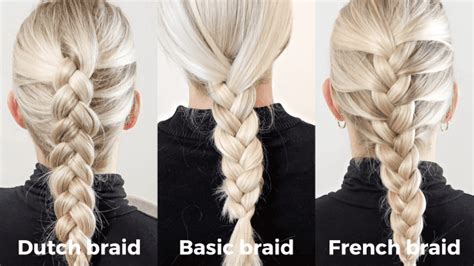Introduction
Dutch and French braids, two timeless and versatile hairstyles, have captured the hearts of braid enthusiasts for centuries. While both techniques create intricate and elegant plaits, subtle differences set them apart. This comprehensive guide explores the key distinctions, pros, cons, and styling variations of these iconic braids.

Dutch Braid vs. French Braid: The Key Differences
1. Placement of New Hair Strands:
– Dutch Braid: New strands are crossed under the previous strands, creating a fuller and more prominent braid.
– French Braid: New strands are crossed over the previous strands, resulting in a flatter and more intricate braid.
2. Appearance:
– Dutch Braid: Appears thicker and textured, with a raised effect.
– French Braid: Looks more delicate and refined, with a woven texture.
3. Difficulty:
– Dutch Braid: Can be slightly more challenging to learn than a French braid, as it requires precise underhand crossing.
– French Braid: Generally easier to master and suitable for beginners.
Pros and Cons of Dutch and French Braids
Dutch Braids:
Pros:
– Thicker and fuller appearance
– Adds volume to hair
– Can hide split ends or hair damage
– Suitable for all hair types
Cons:
– More time-consuming to create
– Can be more difficult to learn
French Braids:
Pros:
– Delicate and intricate appearance
– Flatters most face shapes
– Can be dressed up or down
– Suitable for all hair types
Cons:
– May appear less voluminous than a Dutch braid
– Can be more susceptible to frizz
Styling Variations
Dutch and French braids offer endless styling possibilities. Here are 7 popular variations:
| Variation | Description |
|---|---|
| Basic Dutch/French Braid: Classic 3-strand braid starting at the crown | |
| Inverted Dutch/French Braid: Starts at the nape of the neck, with strands crossed under/over | |
| Pull-Through Braid: A loose and voluminous twist on the traditional Dutch/French braid | |
| Milkmaid Braid: Two Dutch/French braids wrapped around the head | |
| Dutch/French Fishtail Braid: A combination of the Dutch/French braid and the fishtail technique | |
| Crown Braid: A Dutch/French braid wrapped around the top of the head | |
| Halo Braid: A Dutch/French braid that encircles the head like a halo |
Historical Origins and Cultural Significance
French and Dutch braids have a rich history dating back centuries. The French braid, originating in France, gained popularity in the 16th century. The Dutch braid, also known as the “Underhand Braid,” is believed to have originated in the Netherlands during the 17th century. Both braids have been adopted by cultures worldwide, becoming beloved hairstyles for various occasions.
Dutch and French Braids in the Modern Era
Today, Dutch and French braids continue to reign as timeless and versatile hairstyles. They are embraced by fashion icons, celebrities, and hair enthusiasts alike. From runway shows to red carpet events, these braids add an element of elegance, sophistication, and playfulness to any look.
Innovative Applications
The versatility of Dutch and French braids extends beyond traditional hairstyles. Here are two innovative applications that showcase their potential:
1. Dutch/French Braid Wrapping:
– Braiding cords or wires into electrical cables to provide protection and insulation.
– Wrapping Dutch/French braids around jewelry pieces to create unique and ornate designs.
2. Dutch/French Braid Textiles:
– Weaving Dutch/French braid patterns into fabrics to create textured and decorative textiles.
– Incorporating Dutch/French braid elements into embroidery and quilting designs.
Conclusion
Dutch and French braids stand as two iconic and adaptable hairstyles that have captured hearts for generations. Whether you prefer the voluminous texture of a Dutch braid or the intricate elegance of a French braid, these versatile plaits offer endless styling possibilities. Embrace their historical charm and modern applications to enhance your hair and unleash your creativity.
